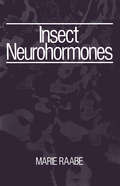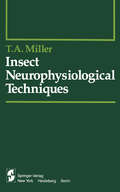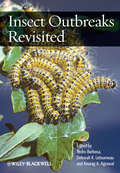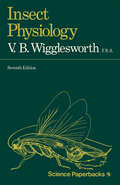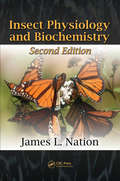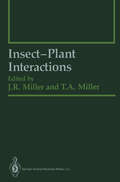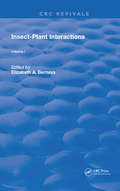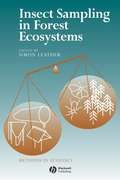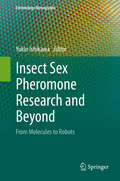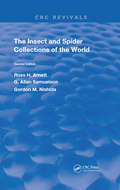- Table View
- List View
Insect Natural History (Collins New Naturalist Library #8)
by A. D. ImmsInsect Natural History introduces the reader to some of the latest discoveries and ideas about British Insects.
Insect Neurohormones
by Marie RaabeThe discovery of insect neurohormones dates from the earliest experimental in vestigations in insect endocrines, and the matter cannot be discussed without evoking the names of its pioneers-Kopec, Wigglesworth, Fraenkel. Whereas the experiments demonstrated the existence of the first known neurohormones, the formulation of the concept of neurosecretion was of fundamental importance to further progress, and tribute must be paid to Ernst and Berta Scharrer. The recent proliferation of investigations into insect neurohormones has cre ated the need for an overall review of the data. Our knowledge of the subject is voluminous, and the evidence clearly demonstrates that neurohormones playa part in most insect regulatory processes. This book analyzes and synthesizes the data, starting from neurosecretion (i.e., source sites and release modes of neurohormones) and continuing through the various functions in which neurohormones have been shown to be involved: endocrine gland activity; diapause; reproduction; visceral muscle functioning; color change; behavior; water and ion balance; protein, sugar, and lipid metabo lism; and tanning and other processes occurring at the cuticle level. In each chapter, besides the experimental information, technical procedures as well as recent information concerning purification of the particular neurohor mones and their mode of action are reported. Numerous exhaustive tables allow the reader to get an overview of the matter while the major findings of the mo ment are presented in the conclusion of each chapter.
Insect Neurophysiological Techniques (Springer Series in Experimental Entomology)
by T.A. MillerInsects as a group occupy a middle ground in the biosphere between bacteria and viruses at one extreme, amphibians and mammals at the other. The size and general nature of insects present special problems to the student of entomology. For example, many commercially available instruments are geared to measure in grams, while the forces commonly encountered in studying insects are in the milligram range. Therefore, techniques developed in the study of insects or in those fields concerned with the control of insect pests are often unique. Methods for measuring things are common to all sciences. Advances sometimes depend more on how something was done than on what was measured; indeed a given field often progresses from one technique to another as new methods are discovered, developed, and modified. Just as often, some of these techniques find their way into the classroom when the problems involved have been sufficiently ironed out to permit students to master the manipulations in a few laboratory periods. Many specialized techniques are confined to one specific research labo ratory. Although methods may be considered commonplace where they are used, in another context even the simplest procedures may save con siderable time. It is the purpose of this series (1) to report new develop ments in methodology, (2) to reveal sources of groups who have dealt with and solved particular entomological problems, and (3) to describe ex periments which might be applicable for use in biology laboratory courses.
Insect Olfaction
by Bill S. HanssonJOHN G. HILDEBRAND Research on insect olfaction is important for at least two reasons. First, the olfactory systems of insects and their arthropod kin are experi mentally favourable models for studies aimed at learning about general principles of olfaction that apply to vertebrates and invertebrates alike. Detailed comparisons between the olfactory pathways in vertebrates and insects have revealed striking similarities of functional organisation, physiol ogy, and development, suggesting that olfactory information is processed through neural mechanisms more similar than different in these evolution arily remote creatures. Second, insect olfaction itself is important because of the economic and medical impact of insects that are agricultural pests and disease vectors, as well as positive impact of beneficial species, such as the bees and moths responsible for pollination and production of honey. The harm or benefit attributable to an insect is a function of what it does - that is, of its behaviour - which is shaped by sensory information. Often olfaction is the key modality for control of basic insect behaviour, such as ori entation and movement toward, and interactions with, potential mates, appro priate sites for oviposition, and sources of food. Not surprisingly, therefore, much work on insect olfaction has been motivated by long-term hopes of using knowledge of this pivotal sensory system to design strategies for mon itoring and managing harmful species and fostering the welfare of beneficial ones.
Insect Outbreaks Revisited
by Pedro Barbosa Deborah K. Letourneau Anurag A. AgrawalThe abundance of insects can change dramatically from generation to generation; these generational changes may occur within a growing season or over a period of years. Such extraordinary density changes or "outbreaks" may be abrupt and ostensibly random, or population peaks may occur in a more or less cyclic fashion. They can be hugely destructive when the insect is a crop pest or carries diseases of humans, farm animals, or wildlife. Knowledge of these types of population dynamics and computer models that may help predict when they occur are very important. This important new book revisits a subject not thoroughly discussed in such a publication since 1988 and brings an international scale to the issue of insect outbreaks. Insect Outbreaks Revisited is intended for senior undergraduate and graduate students in ecology, population biology and entomology, as well as government and industry scientists doing research on pests, land managers, pest management personnel, extension personnel, conservation biologists and ecologists, and state, county and district foresters.
Insect Outbreaks Revisited
by Pedro Barbosa Deborah K. Letourneau Anurag A. AgrawalThe abundance of insects can change dramatically from generation to generation; these generational changes may occur within a growing season or over a period of years. Such extraordinary density changes or "outbreaks" may be abrupt and ostensibly random, or population peaks may occur in a more or less cyclic fashion. They can be hugely destructive when the insect is a crop pest or carries diseases of humans, farm animals, or wildlife. Knowledge of these types of population dynamics and computer models that may help predict when they occur are very important. This important new book revisits a subject not thoroughly discussed in such a publication since 1988 and brings an international scale to the issue of insect outbreaks. Insect Outbreaks Revisited is intended for senior undergraduate and graduate students in ecology, population biology and entomology, as well as government and industry scientists doing research on pests, land managers, pest management personnel, extension personnel, conservation biologists and ecologists, and state, county and district foresters.
The Insect Ovary: Ultrastructure, previtellogenic growth and evolution
by Jürgen BüningThis book will give an overview of insect ovaries, showing the diversities and the common traits in egg growth processes. The idea to write this book developed while looking at the flood of information which appeared in the early 1980s on early pattern formation in Drosophila embryos. At this time a significant breakthrough was made in studies of this little fly, combining molecular biological methods with classical and molecular genetics. The answers to questions about early pattern formation raised new questions about the architecture of ovaries and the growth of eggs within these ovaries. However, by concentrating only on Drosophila it is not possible to form an adequate picture of what is going on in insect ovaries, since the enormous diversity found among insects is not considered sufficiently. Almost forgotten, but the first to study the architecture of ovaries, was Alexander Brandt writing in 1878 in aber das Ei und seine Bildungsstaette (On the egg and its organ of development). More than 100 years later, a series of ten books or more would be required to survey all the serious informa tion we have today on insect oogenesis. Thus, this book is a personal selection and personal view on the theme, and the authors must be excused by all those scientists whose papers could not be included. The book briefly describes the ectodemes, i. e.
Insect Pest Management
by David Dent Dr Richard BinksAn undergraduate and postgraduate textbook covering the key principles, methodologies, approaches and practical examples of insect pest management in agricultural, post harvest systems, horticulture, insect vectors and medical and veterinary entomology. The book covers the underpinning monitoring and forecasting of pest outbreaks, yield loss and impact assessments and all of the latest methods of control and management of insects from insecticides, host manipulation, plant resistance, biological control, use of interference, agronomic and precision control methods as well as socio-economic and research management aspects of developing integrated approaches to pest management. The new edition also reflects the key advances made in the disciplines of molecular biology, biochemistry and genomics related to insects and their management, as well as the importance and role of biodiversity, climate change, precision agriculture, data management and sustainability of production and supply in delivering integrated management solutions.
Insect Pheromone Research: New Directions
by R.T. Carde A.K. MinksThis book contains the proceedings of the "First International Symposium on Insect Pheromones," which was held at Wageningen, The Netherlands, from March 6 to March 11, 1994. Eighty participants from 17 countries attended the symposium, which turned out to be a unique forum for the exchange of the latest worldwide findings on insect pheromones, an opportunity to discuss and debate unsettled issues, and a mechanism to define new directions in pheromone research and foster interdisciplinary collaborations. The meeting comprised five sessions representing the breadth of disciplinary interest in pheromones, a typical charac teristic of this research area. In the sessions the following topics were presented: (1) control of pheromone production (organized by W. L. Roelofs), (2) sensory processing of pheromone signals (T. L. Payne), (3) neuroethology of pheromone mediated responses (T. C. Baker), (4) use of pheromones in direct control (A. K. Minks and R. T. Card6), and (5) evolution of pheromone communication (c. LOfstedt). All sessions started with a series of 30-minute lectures, after which ample time was reserved for discussion. In each session some participants were asked to serve as discussants and to initiate and stimulate discussion, and a rapporteur was recruited to make notes of these discussions and to summarize the general trends emerging from the session. The general program ming of the symposium was in the hands of R. T. Carde, A. K. Minks, and T. L. Payne.
Insect Pheromones and their Use in Pest Management
by P. Howse J.M. Stevens Owen T JonesThere is now a considerable literature on chemical ecology, which had its beginnings in the study of insect pheromones. This beginning was possible only by combining the disciplines and techniques of biology and chemistry. For a biologist, it is difficult to understand the time frames of analytical and synthetic chemistry. A compound may take days to characterize and be available in minutes from a bottle on the shelf, or it may take years to characterize and synthesize. Chemists have a similar frustration: after an intense programme of work, the insect in question may not emerge for many months. study are, however, The rewards of integrated interdisciplinary considerable, because they allow us to understand many facets of insect behaviour and consequently to control that behaviour for our own ends. In this book, we have set out to explain the results of research from chemical and biological perspectives, and see how the knowledge gained has led to novel techniques that can be used in insect pest management and insect control. An important part of understanding insect chemical ecology involves the understanding not only of new concepts but of the vocabularies used by scientists specializing in different fields. It will be clear that the three sections of this book have been written by three different people: an insect behaviourist, an organic chemist and a biologist in industry.
Insect physiology
by Vincent B. Wigglesworthyears ago extensive advances have been made in all parts of the subject. Full-sized textbooks have been devoted to it; notably The Principles of Insect Physiology by the present author, the three volume Physiology of the Insecta edited by Morris Rockstein, and Insect Biochemistry by Darcy Gilmour; and articles describing the most recent advances in the physiology and biochemistry of insects appear in the Annual Review of Entomology, in Advances in Insect Physiology and elsewhere. References in this edition have therefore been confined to such textbooks and reviews, to a few recent papers which have not yet become incorporated in this way, and to a limited number of other papers which provide useful starting-points for further reading. I The Integument The key to much of the physiology of insects is to be found in the nature of their cuticle. As was first shown by Haecke1, the cuticle is the product of a single layer of epidermal cells. It is often described as being composed of non-living material; but in fact the epidermal cells give off fine filaments contained within the so-called 'pore canals', which run through the substance of the cuticle and often come within less than a micron of the surface. Cuticle Structure As described from stained sections the cuticle consists of two primary layers, the endocuticle which makes up the greater part, and a thin refractile epicuticle on the surface, usually not more than one micron in thickness.
Insect Physiology and Biochemistry
by James L. NationExpanded and updated, this second edition of a bestselling book challenges conventional entomological wisdom with the latest research and analytical interpretations. Encouraging independent evaluation of the data and allowing for the extrapolation of major concepts across species, this indispensable text establishes a thorough understanding of the
Insect Physiology and Biochemistry
by James L. Nation, Sr.Employing the clear, student-friendly style that made previous editions so popular, Insect Physiology and Biochemistry, Fourth Edition presents an engaging and authoritative guide to the latest findings in the dynamic field of insect physiology. The book supplies a comprehensive picture of the current state of the function, development, and reproduction of insects. Expanded and updated, now in full colour, this fourth edition adds three new chapters on the role of the nervous system in behavior; the ‘Genomics Revolution’ in entomology; and global climate changes which have a major effect on insects, including warming and weather. It continues to challenge conventional entomological wisdom with the latest research and analytical interpretations. The text will appeal to upper undergraduate and graduate students and to practicing biologists who need to possess a firm knowledge of the broad principles of insect physiology. With detailed full colour illustrations to help explain physiological concepts and important anatomical details, it remains the most easily accessible guide to key concepts in the field.
Insect Physiology and Biochemistry
by James L. Nation, Sr.Employing the clear, student-friendly style that made previous editions so popular, Insect Physiology and Biochemistry, Fourth Edition presents an engaging and authoritative guide to the latest findings in the dynamic field of insect physiology. The book supplies a comprehensive picture of the current state of the function, development, and reproduction of insects. Expanded and updated, now in full colour, this fourth edition adds three new chapters on the role of the nervous system in behavior; the ‘Genomics Revolution’ in entomology; and global climate changes which have a major effect on insects, including warming and weather. It continues to challenge conventional entomological wisdom with the latest research and analytical interpretations. The text will appeal to upper undergraduate and graduate students and to practicing biologists who need to possess a firm knowledge of the broad principles of insect physiology. With detailed full colour illustrations to help explain physiological concepts and important anatomical details, it remains the most easily accessible guide to key concepts in the field.
Insect-Plant Interactions (Springer Series in Experimental Entomology)
by M. Berenbaum S. Finch J. L. Frazier F. J. Hanke F. E. Hanson I. Ishaaya M. Kogan I. Kubo A. C. Lewis S. B. Opp R. J. Prokopy M. C. Singer W. M. Tingey H.F. van EmdenThe authoritative overviews in this volume provide a wealth of practical information on current approaches to the study of insect-plant interactions. Methods described include direct behavioral observation; assays of host finding, oviposition, and feeding behavior of insect herbivores; post-ingestion physiological effects; measurement of food quality and sensory responses of insects to plant stimuli; chemical isolation and identification of active phytochemicals; evaluation of plant resistance to insects; and the biochemistry of allelochemic interactions.
Insect-Plant Interactions (Routledge Revivals #1)
by Elizabeth A. BernaysFirst Published in 1989, this book explores the relationship between plants and insects and the ways in which they interact with each other. Carefully compiled and filled with a vast repertoire of notes, diagrams, and references this book serves as a useful reference for students of oncology, and other practitioners in their respective fields.
Insect-Plant Interactions (Routledge Revivals #1)
by Elizabeth A. BernaysFirst Published in 1989, this book explores the relationship between plants and insects and the ways in which they interact with each other. Carefully compiled and filled with a vast repertoire of notes, diagrams, and references this book serves as a useful reference for students of oncology, and other practitioners in their respective fields.
Insect Populations In theory and in practice: 19th Symposium of the Royal Entomological Society 10–11 September 1997 at the University of Newcastle
by Jack P. Dempster Ian F. G. McLeanInsects are by far the largest group of animals on Earth, with over a million described species, and they occupy a wide range of ecological niches - they may be herbivores, predators, parasites or decomposers. Some are of particular economic importance as pests of agriculture and forestry, as vectors of animal and human disease, or as species of interest to wildlife conservation. Thus an understanding of the processes determining their numbers is of considerable practical value. Entomologists have played a leading role in developing a theoretical basis to Population Ecology, but we still do not have adequate experimental and observational proof for many of the theoretical ideas that have been proposed. As a result, the subject has been beset with arguments for more than 50 years. This volume attempts to reconcile some of these controversies, while also reviewing the current state of our knowledge. The editors have drawn together an international list of contributors whose views reflect a range of opinions on how natural populations are stabilised. They have succeeded in producing a book that both covers the main alternative views in population theory and contains some of the best recent field studies of insect populations. This Royal Entomological Society Symposium volume will be of great interest to all entomologists and ecologists, particularly those who wish to know more about Population Dynamics.
Insect Predators in Pest Management
by OmkarPests cause damage to the economic value of crops and stored products, while vectors are responsible for the transmission of disease-causing agents in human beings and livestock. Although application of synthetic pesticides in agriculture gives immediate relief, it also causes well-known side effects, leading to a consensus among entomologists and agriculturists to shift towards other ecofriendly pest management methods. Natural enemies of insects including their predators, parasitoids and pathogens have attracted the attention of scientists across the globe. These natural enemies exist in agroecosystems and suppress the populations of pests. Parasitoids are farmers’ friends and the most successful group of natural enemies. Highly specialized/generalized in their prey choice, active stages of predators search for a suitable prey, attack or kill the prey and consume prey within a short handling time. Predatory ability is known to increase with increase in prey density. A single predator may devour several prey individuals. Exploiting this potency of parasitoids may yield successful results in controlling notorious pests in an ecofriendly way. This book provides information on the important biocontrol agents that are effective in pest suppression. It starts with insect parasitic groups followed by specific group of parasitoids. It is hoped that the book presents a comprehensive account of beneficial parasitoids and will be useful to undergraduate and postgraduate students of Entomology, Biological Control, Plant Protection, Agricultural Zoology and Zoology, besides those involved in competitive examinations and policy planning. Features Each chapter has been authored by specialized senior professionals. Every chapter contains Learning Objectives and Points to Remember. This book offers comprehensive knowledge of parasitoids and their application in pest management in a lucid way.
Insect Predators in Pest Management
by OmkarPests cause damage to the economic value of crops and stored products, while vectors are responsible for the transmission of disease-causing agents in human beings and livestock. Although application of synthetic pesticides in agriculture gives immediate relief, it also causes well-known side effects, leading to a consensus among entomologists and agriculturists to shift towards other ecofriendly pest management methods. Natural enemies of insects including their predators, parasitoids and pathogens have attracted the attention of scientists across the globe. These natural enemies exist in agroecosystems and suppress the populations of pests. Parasitoids are farmers’ friends and the most successful group of natural enemies. Highly specialized/generalized in their prey choice, active stages of predators search for a suitable prey, attack or kill the prey and consume prey within a short handling time. Predatory ability is known to increase with increase in prey density. A single predator may devour several prey individuals. Exploiting this potency of parasitoids may yield successful results in controlling notorious pests in an ecofriendly way. This book provides information on the important biocontrol agents that are effective in pest suppression. It starts with insect parasitic groups followed by specific group of parasitoids. It is hoped that the book presents a comprehensive account of beneficial parasitoids and will be useful to undergraduate and postgraduate students of Entomology, Biological Control, Plant Protection, Agricultural Zoology and Zoology, besides those involved in competitive examinations and policy planning. Features Each chapter has been authored by specialized senior professionals. Every chapter contains Learning Objectives and Points to Remember. This book offers comprehensive knowledge of parasitoids and their application in pest management in a lucid way.
Insect Repellents Handbook
by Mustapha Debboun Stephen P. Frances Daniel StrickmanThe public has a great desire for products that prevent the annoyance of biting insects and ticks, but that desire does not always translate into sensible use of those products. Insect Repellents Handbook, Second Edition summarizes evidence-based information on insect repellents to inform decisions by those involved with insect repellent research,
Insect Sampling in Forest Ecosystems
by Simon R. LeatherInsect Sampling in Forest Ecosystems highlights the problems faced by entomologists working in forest ecosystems. Insects play a major part in all aspects of ecology Brings together the methodology needed to investigate insects through the various strata of the forest canopy Covers techniques associated with various specialised groups of forest insects Each chapter is backed up by a sound approach to experimental design and data analysis Essential reading for advanced students and researchers as well as teachers
Insect Sex Pheromone Research and Beyond: From Molecules to Robots (Entomology Monographs)
by Yukio IshikawaThis book provides a complete overview of cutting-edge research on insect sex pheromones and pheromone communication systems. The coverage ranges from the chemistry, biosynthesis, and reception of sex pheromones to the control of odor-source searching behavior, and from molecules to the application of research findings to robotics. The book both summarizes the progress of studies conducted using Bombyx mori and several groups of moths and reviews sex pheromones of some non-lepidopteran insect groups of agricultural importance. Attention is drawn to recent findings on elaborate neural information processing in the brain in male moths and to the importance of olfactory receptors specifically tuned to sex pheromone molecules. Featuring contributions from leading experts on the topic, this book will be a unique and valuable resource for researchers and students in the fields of entomology, chemical ecology, insect physiology and biochemistry, evolution, biomimetics, and bioengineering. In addition to researchers, general insect lovers will find the book fascinating for its descriptions of the marvelous abilities of insects and the underlying mechanisms involved.
The Insect & Spider Collections of the World (CRC Press Revivals)
by Ross H. Arnett, Jr. G. Allan Samuelson Gordon M. NishidaFirst published in 1993, completely rewritten, this second edition includes a list of all 210 countries of the world and all of the islands, with comments on the existence of insect and spider collections, both public and private. These listings are arranged alphabetically by country, state/province, and city, with private collections listed under the public collection with which they are registered. Part II of the directory is an alphabetical list of the codes assigned to each of the collections described in Part I. This list is also cross-referenced to variations of the codes used in other works, which will eliminate any confusion over this duplication. This classic work provides a ready reference to all collections and is required by all insect and spider systematists.
The Insect & Spider Collections of the World (CRC Press Revivals)
by Ross H. Arnett, Jr. G. Allan Samuelson Gordon M. NishidaFirst published in 1993, completely rewritten, this second edition includes a list of all 210 countries of the world and all of the islands, with comments on the existence of insect and spider collections, both public and private. These listings are arranged alphabetically by country, state/province, and city, with private collections listed under the public collection with which they are registered. Part II of the directory is an alphabetical list of the codes assigned to each of the collections described in Part I. This list is also cross-referenced to variations of the codes used in other works, which will eliminate any confusion over this duplication. This classic work provides a ready reference to all collections and is required by all insect and spider systematists.

